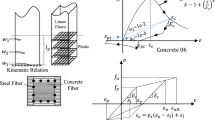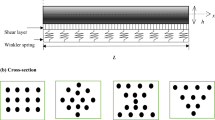Abstract
The effect of the shape of the strain-softening diagram on the bearing capacity of three-point loaded beams, as calculated by the “fictitious crack model”, is analysed. It is shown that if, at peak load, the openings at the nodes along the fracture zone are smaller than the displacement corresponding to the break-point of the bilinear softening approximation, the maximum load only depends on the slope of its initial linear portion. A “limit break-point” (L) is defined such that bilinear strain-softening diagrams with the same initial slope, and whose break-points are located beyond Point L, will lead to the same maximum load of bent beams. The location of that “limit break-point” as a function of initial slope, beam size and notch depth is also studied; the effect of these variables is explained in terms of notch sensitivity.
Similar content being viewed by others

References
Hillerborg, A., Modéer, M. and Petersson, P. E., ‘Analysis of crack formation and crack growth in concrete by means of fracture mechanics and finite elements’,Cem. Concr. Res. 6 (1976) 773–782.
Modéer, M., ‘A fracture mechanics approach to failure analyses of concrete materials’, Report TVBM-1001 (Division of Building Materials, University of Lund, Sweden, 1979).
Petersson, P. E., ‘Crack growth and development of fracture zones in plain concrete and similar materials’, Report TVBM-1006 (Division of Building Materials, University of Lund, Sweden, 1981).
Hillerborg, A., ‘Analysis of one single crack’, inFracture Mechanics of Concrete, edited by F. H. Wittmann (Elsevier, Amsterdam, 1983) pp. 223–249.
Gustaffson, P. J., ‘Fracture mechanics studies of non-yielding materials like concrete’, Report TVBM-1007 (Division of Building Materials, University of Lund, Sweden, 1985).
Roelfstra, P. E. and Wittmann, F. H., ‘Numerical method to link strain-softening with failure of concrete’, inProceedings of RILEM International Conference on Fracture Mechanics of Concrete. Ecole Polytechnique Federale de Lausanne, Lausanne (Switzerland), October 1985, pp. 127–139.
Rots, J. G., ‘Analysis of crack propagation and fracture of concrete with DIANA’, Report No. BI-83-26/68.3.0220 (TNO-IBBC, Delft, 1983).
Rots, J. G., Nauta, P., Kusters, G. M. A. and Blaauwendraad, J., ‘Smeared crack approach and fracture localization in concrete’,HERON Vol. 30, No. 1 (Delft, 1985).
Alvaredo, A. M., ‘Final report on the computer modelling of fracture mechanics approaches applied to concrete’, Joint Research Project INTI-KFK on Cracking of Concrete (Institut f. Massivbau u. Baustofftechnologie, University of Karlsruhe, 1985).
Author information
Authors and Affiliations
Rights and permissions
About this article
Cite this article
Alvaredo, A.M., Torrent, R.J. The effect of the shape of the strain-softening diagram on the bearing capacity of concrete beams. Materials and Structures 20, 448–454 (1987). https://doi.org/10.1007/BF02472496
Published:
Issue Date:
DOI: https://doi.org/10.1007/BF02472496



